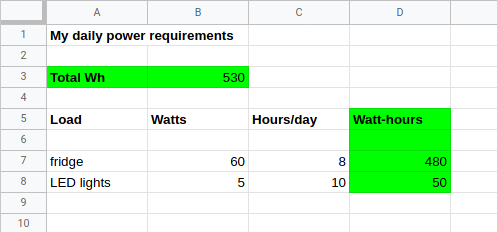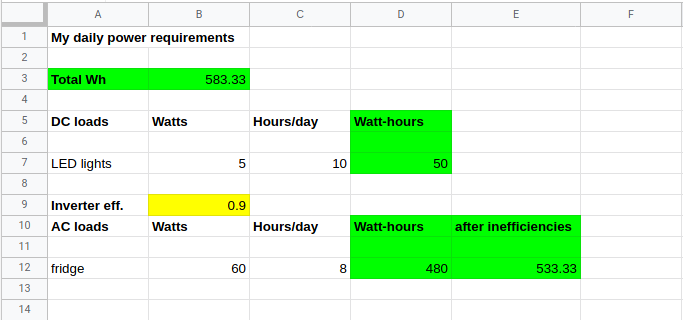Table of Contents
DRAFT
How much power do I need to run stuff?
It may seem overwhelming at first, but all we really need are
- a list of things you intend to run in the van. Be specific and thorough. ← the hardest part.
- reading the product labels on the above items
- some math you already know from when you were a kid (addition, multiplication, maybe some division)
The primary goal is how to figure out how much power you will require on a daily basis; this is called the daily power requirement. We will work through simple examples step by step and end up with watt-hours (Wh, see below).1)
look at the labels
All electrical appliances (aka loads) have labels/stampings on them2) that describe how much power they draw.
- Most are in watts, which we will use directly for our math.
- Sometimes they don't show watts but only Amps and Volts (example: 120vac, 2A). Amps x volts = watts, so our example would consume 240w. Easy peasy.
- the rated power is often the max power the device can consume. They may use less over time (a laptop with a 90w adapter may pull 90w only when running at 100%); to know for sure use a kill-a-watt to measure actual energy use over a full day or more.
how long will you run each load?
Watts are only half the story. We need to know how long the you will run the doodad on average each day.
- if we run the example doodad for 1.5 hours, the energy required is 360Wh (240W x 1.5 hours). Easy peasy.
NOTE: some loads, even if plugged in 24/7, cycle on and off. A good example is a compressor refrigerator. A common rule of thumb is that a fridge will run the compressor ~1/3 of the time. So you would use 8 hours instead of 24 hours for that load. (24 / 3 = 8).3)
add them all up
- do this for every load you want to run
- add them up
- that's it, if we want the general picture
It may be easiest to do this in a spreadsheet where you can see all the loads at once, and twiddle numbers to see how it affects your daily power requirements. Here's a simple example:
The numbers in green were calculated automagically by the spreadsheet.
Aside: if you haven't made or used a spreadsheet before, here is a beginner's intro on youtube. Many computers come with a spreadsheet program (like Excel) and there are free ones like LibreOffice Calc and free online ones like Google Sheets, etc. Google Sheets was used for the screenshots in this article.
building a more accurate estimate
The more accurate your estimate the easier it will be to build a system that meets your needs on your budget.
inverter losses
Individual loads in the van will be either
- DC (ex: 12vdc); or
- AC run off an inverter (ex: 120vac)
Loads run off inverter will draw more power because of inverter losses4). The inverter specifications will say exactly what this the efficiency rate is, but for our purposes we will assume 90% (i.e. 0.9).
To get a more accurate estimate when can enter this efficiency rating into the spreadsheet, divide loads into DC/AC, and let the spreadsheet do the work for us:
The number is yellow is the inverter efficiency. I typed that in one spot so the spreadsheet could refer to it as often as it needs to.
A couple observations:
- we could save ~53Wh by running the fridge off DC rather than AC, if the fridge has that capability
- this is a giant PITA for only two loads. But when you get to ten or twenty (or more) loads the spreadsheet starts to shine. It also allows you to easily see the increase/decrease from using, say, a 45w or 90w fridge instead of a 60w one.
also consider your highest-current loads
Sometimes a load doesn't use much energy (Wh) because runtimes are short, but still consumes a lot of power (W). An example might be an electric coffeemaker.
It might run for only 5 minutes a day (1200w / 60 minutes in an hour * 5 minutes) = 100Wh. But during that run it is pulling ~118A (1200w / 0.85 inverter losses / 12v). So the entire system (batteries, wiring, inverter) has to be sized to that 118A load thar runs only 5 minutes a day. Do you love that Keurig enough to buy extra batteries, fatter wire, and a bigger inverter to run it?
also see How Do I Run This Load?
now what?
Now that we assessed our daily power and max current requirements we can think about
- assessing our energy storage and autonomy requirements



